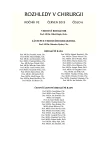Reexpansion pulmonary oedema after drainage of a long-term spontaneous pneumothorax – a case report
Authors:
D. Myšíková; J. Šimonek; A. Stolz; R. Lischke
Authors‘ workplace:
III. chirurgická klinika 1. LF UK a FN Motol, přednosta kliniky: Prof. MUDr. R. Lischke, PhD.
Published in:
Rozhl. Chir., 2013, roč. 92, č. 6, s. 333-336.
Category:
Case Report
Podpořeno MZ ČR – RVO, FN v Motole 00064203
Overview
Reexpansion pulmonary oedema is a rare but possibly lethal complication of thoracic drainage for pneumothorax. Morbidity and mortality of this complication remains high (up to 20% of lethal cases) and as such deserves our attention. We report a case of ipsilateral left-sided pulmonary oedema following chest tube insertion in a 42-year-old male patient with spontaneous pneumothorax. Pneumothorax can be expected to last for up to 3 weeks (from the first presentation of sudden dyspnoea and chest pain). The pathophysiology of this lung affection has not yet been completely elucidated; the crucial role is probably played by damage to the endothelium which is followed by increased endothelial permeability during ischemia-reperfusion injury in a rapidly reexpanding lung. The main risk factors for the development of RPE are young age (the younger the patient, the higher the risk), the female sex, the degree of lung collapse, a pneumothorax that lasts more than 24 hours, a reexpansion of the lung in less than ten minutes, the use of a suction system, and – in cases of a pleural effusion – an evacuation volume of more than 2000 ml. Although in patients with these risk factors the administration of initial negative pressure should be avoided, this procedure remains common practice in pneumothorax treatment in the Czech Republic. Thoracic surgeons are more likely to use the suction system than pulmonologists (70% versus 52%). RPE manifestation ranges from benign clinical course (patients are free of complaints with only pathological chest radiography findings) to potentially lethal rapid respiratory failure with circulatory shock. Most patients develop RPE within 1 hour of expansion and the ipsilateral lung is affected. Only rarely can pulmonary oedema be bilateral, or in the contra-lateral lung. Treatment of RPE is supportive and depends on the individual patient’s condition, ranging from mere monitoring to mechanical ventilation for serious cases. Positive pressure mechanical ventilation and the utilization of positive end-expiratory pressure (PEEP) remains the gold standard of treatment.
Key words:
reexpansion pulmonary oedema – pneumothorax – acute respiratory failure
Sources
1. Mahfood S, Hix WR, Aaron BL, et al. Reexpansion pulmonary edema. Ann Thorac Surg 1998;45 : 340–345.
2. Sivrikoz MC, Tuncozgur B, Cekman M, et al. The role of tissue reperfusion in the reexpansion injury of the lungs. Euro J Cardiothorac Surg 2002;22 : 721–7.
3. Iqbal M, Multz AS, Rossoff LJ, et al. Reexpansion pulmonary edema after VATS successfully treated with continuous positive airway pressure. Ann Thorac Surg 2000;70 : 669–71.
4. de Campos JRM, Vargas FS, Werebe EDC. Thoracoscopy talc poudrage.Chest 2001,119 : 801–806.
5. Matsumiya N, Dohi S, Kimura T, Naito H. Reexpansion pulmonary edema after mediastenal tumor removal. Anesth Analg 1991;73 : 646–8.
6. Pinault H. Considérations cliniques sur la thoracentŹse.[doctoral thesis]. Paris 1853.
7. Carlson RL, Classen KL, Gollan F, et al. Pulmonary edema following the rapid expansion of a totally collapsed lung due to pneumothorax: A clinical and experimental study. Surg Forum 1958;9 : 367–371.
8. Peatfield RC, Edwards PR, Johnson NMcI: Two unexpected deaths from pneumothorax. Lancet 1979;1 : 356–8.
9. Brooks JW. Open thoracotomy in the management of spontaneous pneumothorax. Ann Surg 1973;177 : 795–805.
10. Mills M, Balsch BF. Spontaneous pneumothorax: a series of 400 cases. Ann Thorac Surg 1965;1 : 286–97.
11. Baumann MH, Strange C, Heffner JE, Light R, Kirby TJ, Klein J, Luketich JD, Panacek EA, Sahn SA. Management of spontaneous pneumothorax: an American College of Chest Physicians Delphi consensus statement. Chest 2001;119,2 : 590–602.
12. Stolz A, Harustiak T, Pafko P. Spontaneous pneumothorax management. Eur Surg 2008;40,4 : 1–613.
13. Sivrikoz MC, Tuncozgur B, Cekman M, et al. The role of tissue reperfusion in the reexpansion injury of the lungs. Euro J Cardiothorac Surg 2002;22 : 721–7.
14. Hidalgo MA, Shah KA, Fuller BJ, Green CJ. Cold ischemia-induced damage to vascular endothelium results in permeability alterations in transplanted lungs. J Thorac Cardiovasc Surg 1996;112 : 1027–1035.
15. Christie JD, Bavaria JE, Palevsky HI, Litzky L, Blumenthal NP, Kaiser LR, Kotloff RM. Primary graft failure following lung transplantation. Chest 1998;114 : 51–60.
16. Iqbal M, Multz AS, Rossoff LJ, et al. Reexpansion pulmonary edema after VATS successfully treated with continuous positive airway pressure. Ann Thorac Surg 2000;70 : 669–71.
17. Thille AW. Patient-ventilator asynchrony during assisted mechanical ventilation. Intensive Care Med 2006;32 : 1515–1522.
18. Cho SR, Lee JS, Kim MS. New treatment method for reexpansion pulmonary edema: Differential lung ventilation. Ann Thorac Surg 2005;80 : 1933–4.
Labels
Surgery Orthopaedics Trauma surgeryArticle was published in
Perspectives in Surgery

2013 Issue 6
Most read in this issue
- Reexpansion pulmonary oedema after drainage of a long-term spontaneous pneumothorax – a case report
- Circumferential resection margin in the modern treatment of rectal cancer
- Incarcerated De Garengeot’s hernia complicated by gangrenous appendicitis
- Anatomic-surgical study of intercostobrachial nerve (ICBN) course in axilla during I. and II. level of axilla clearance in breast cancer and malignant melanoma
